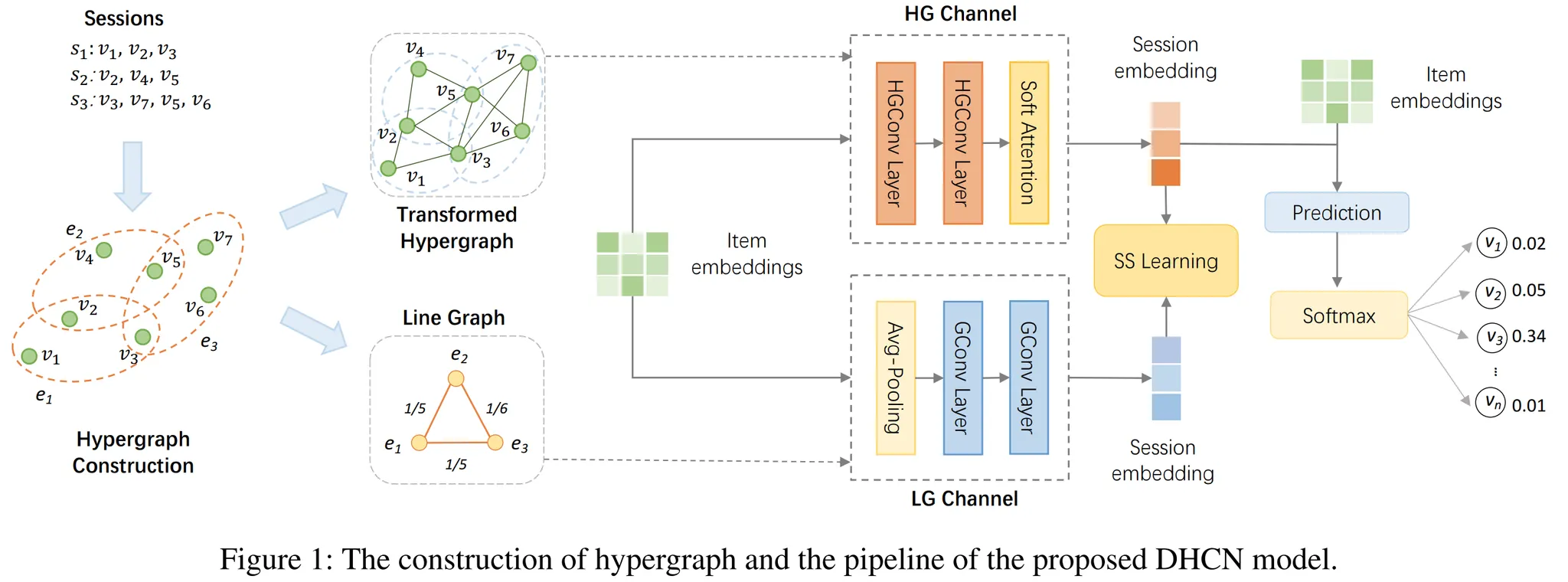ABSTRACT
Session-based recommendation (SBR) focuses on next-item prediction at a certain time point. As user profiles are generally not available in this scenario, capturing the user intent lying in the item transitions plays a pivotal role. Recent graph neural networks (GNNs) based SBR methods regard the item transitions as pairwise relations, which neglect the complex high-order information among items. Hypergraph provides a natural way to capture beyond-pairwise relations, while its potential for SBR has remained unexplored.
In this paper, we fill this gap by modeling session-based data as a hypergraph and then propose a hypergraph convolutional network to improve SBR. Moreover, to enhance hypergraph modeling, we devise another graph convolutional network which is based on the line graph of the hypergraph and then integrate self-supervised learning into the training of the networks by maximizing mutual information between the session representations learned via the two networks, serving as an auxiliary task to improve the recommendation task.
Since the two types of networks are both based on hypergraph, which can be seen as two channels for hypergraph modeling, we name our model DHCN (Dual Channel Hypergraph Convolutional Networks). Extensive experiments on three benchmark datasets demonstrate the superiority of our model over the SOTA methods, and the results validate the effectiveness of hypergraph modeling and self-supervised task. The implementation of our model is available via https://github.com/xiaxin1998/DHCN.
Plain Text
복사
SUMMARY
•
General Background
◦
Long-term user profiles are usually not available in Session-based Recommendation(SBR).
◦
Most of the research efforts in this area regard the sessions as ordered sequences.
•
RNN Approaches
◦
In RNNs-based approaches, modeling session-based data as unidirectional sequences has been deemed the key to success, but it ignores the coherence of items.
◦
Sometimes set of items is more important than the order of items.
•
GNN Approaches
◦
Unlike the RNNs-based recommendation method, the GNNs-based-approaches model session-based data as directed subgraphs and item transition as pairwise relations.
◦
But the previous model only showed small improvements because they neglected the complex item correlations in session-based data.
•
Current Hypergraph Approach
◦
Proposes a novel SBR approach upon hypergraph to model the high-order relations among items within sessions
◦
Hypergraph
▪
Composed of a vertex set and a hyperedge set, where a hyperedge can connect any number of vertices, which can be used to encode high-order data correlations
◦
Assumes that items in a session are temporally correlated but not strictly sequentially dependent.
◦
Emphasize the coherence of the involved elements rather than relative orders
◦
First, model each session as a hyperedge in which all the items are connected with each other
◦
Second, Different hyperedge constitute the hypergraph
•
Issues
◦
Hyperedge only contains a limited number of items
◦
Inherent data sparsity issues might limit the benefits brought by hypergraph modeling
◦
line graph channel and innovatively integrate self-supervised learning
◦
Dual channel Hypergraph Convolutional Network (DHCN)
◦
Maximize the mutual information between the session representations
•
Contribution
◦
Dual channel hypergraph convolutional network for SBR
◦
Integrate a self-supervised task
•
Results

